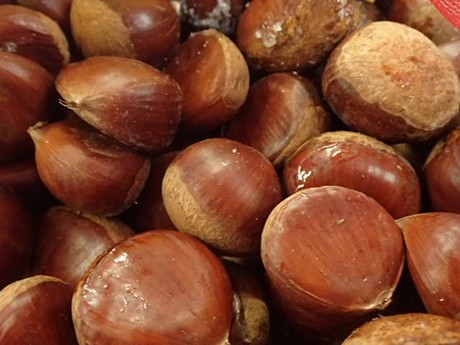
Chestnuts are also grown in Italy, France, Spain and Portugal. “But,” says Harry, “price-wise we think China is the best choice. The French want about 20 euro for a small bale, while the Chinese want 13 euro. The size is the same and quality is good. Whether one tastes better than the other: tastes differ. When you open the chestnut it should have a yellow colour on the inside. That means the chestnut will taste sweet. When they’re white they won’t be ripe and will taste bitter.”
Preventing mould
Chestnuts are very sensitive to mould. Temperatures during transport are very important for quality. “After the chestnuts are harvested, they’ll get a protective bath. To keep moisture content level, a piece of cloth is placed over the entire pallet. When temperatures increase, the nuts become dry. The result is that the flavour decreases and the product loses weight, and we naturally don’t want that.”
Denimpex supplies chestnuts to wholesalers and suppliers. The majority of sales is shipped to Eastern European countries such as the Czech Republic and Poland. Besides, they also have buyers in the Netherlands, Belgium and Sweden. “We’re actually a kind of distribution channel,” Harry clarifies. “In those countries, the market is bigger than in the Netherlands. Chestnuts are an important ingredient for confectionery there.”
Fewer importers
Since 1990, Harry and Danny Deen have been the second generation to run the family company that was founded by Abraham Deen in 1955. Denimpex imports and exports a wide range of various varieties of fruit, vegetables and exotics globally. They’ve had chestnuts in their range for about 15 years now. Over the years, Harry has seen the market changing. “In the past, many different importers supplied chestnuts, that number is much lower nowadays. The ones still around know what they’re doing. The chestnut isn’t an easy import product. You’re dealing with a lot of different sales channels, and you have to be able to guarantee quality and freshness.”
More has changed over the years. The burlap bags used to pack chestnuts in the past have been replaced with plastic net packaging. “Because of this, more air can reach the chestnuts, so that the chance of mould is decreased. An additional advantage is that the customers can see the product. We supply bales of five kilos, and we also have consumer packaging of one kilo and 500 grammes. Size designation sometimes causes confusion. We supply size 40 to 60. These aren’t centimetres, like with onions, but the number of chestnuts per kilo.”
Chestnuts have their peak around Christmas. People going to Christmas markets can always find booths selling roasted chestnuts. Demand declines after the turn of the year. Mid-January, Denimpex stops supplying chestnuts to completely focus on the distribution of other products again.





